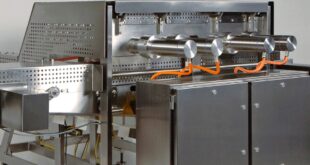Festo has introduced a new cantilever axis with toothed belt that has been optimised for vertical applications where short cycle times are important.
Suitable for pushing and pressing, the ELCC series is particularly suited to the requirements of the packaging, automotive and machine tool sectors.
Thanks to its innovative construction, the ELCC series improves upon previous Festo models by offering a combination of excellent rigidity, minimal moving mass and high dynamics.
As a result, the ELCC offers the potential to cut damping of vibrations at the front end by up to 50%.
The improved ratio between moving mass and rigidity also allows higher acceleration, delivering up to 30% shorter cycle times.
Cantilever axes like the ELCC series are used wherever the axis has to leave the working space after motion has been completed.
Examples include vertical motion involving loading and unloading, motion through doors to closed working spaces, and motion in dirty working spaces.
Typical applications include the erection, loading and sealing of cardboard boxes in packaging facilities; handling of engines and transmissions or feeding metal sheeting in automotive assembly lines; and handling tools during machine tool changeovers.

The ELCC series can be used as a Z-axis in combination with Festo EGC, EGC-HD and ELGA in 2D or 3D systems.
Recommended vertical payloads are between 10-100kg, with maximum torques of 35, 100, 170 or, 310Nm depending on model size selection.
Offering a repetition accuracy of ± 0.05mm, each ELCC cantilever axis operates at maximum speeds of 5mm per second and has a stroke length of 2000mm as standard.
A modular system design enables specifiers and machine builders to customise the ELCC to meet individual application requirements.
Users can select from four different widths (60, 70, 90, 110mm) and three different toothed belt variants: a standard black rubber belt for long service life, an FDA-compliant white, uncoated PU (polyurethane) for hygienic applications, or a green coated PU belt which offers good resistance to cooling lubricants.
The ELCC can be supplied with or without a stainless steel guide cover, an integrated clamping unit, or an additional slide. There is also an option to incorporate an incremental displacement encoder with a resolution of 2.5µm.
The ELCC’s performance means it is often possible to select smaller sizes, making the overall system more compact and less expensive.
 Engineer News Network The ultimate online news and information resource for today’s engineer
Engineer News Network The ultimate online news and information resource for today’s engineer





